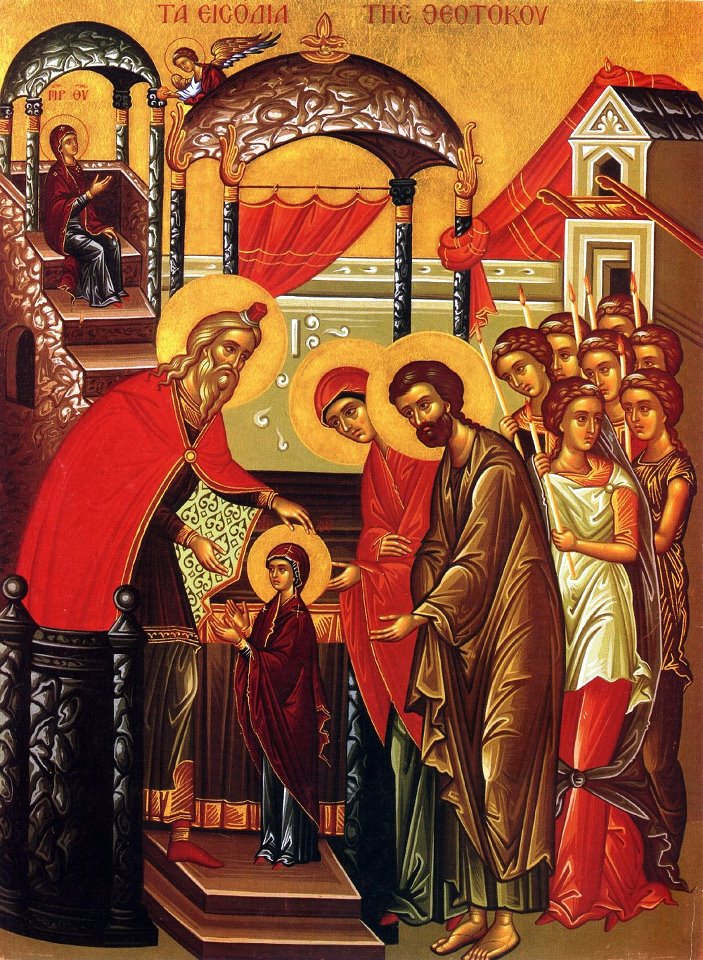Entrance of the Theotokos to the Temple

The second great feast of the Theotokos is the celebration of her entrance as a child into the Jerusalem Temple which is commemorated on the twenty-first of November. Like the feast of her nativity, this feast of Mary is without direct biblical and historical reference. But like the nativity, it is a feast filled with important spiritual significance for the Christian believer.
The texts of the service tells how Mary was brought as a small child to the temple by her parents in order to be raised there among the virgins consecrated to the service of the Lord until the time of their betrothal in marriage. According to Church tradition, Mary was solemnly received by the temple community which was headed by the priest Zacharias, the father of John the Baptist. She was led to the holy place to be “nourished” there by the angels in order to become herself the “holy of holies” of God, the living sanctuary and temple of the Divine child who was to be born in her.
There is no doubt that the verses of the Old Testamental Psalm 45, used extensively in the services of the feast, provided a great inspiration for the celebration of Mary’s consecration to the service of God in the Jerusalem Temple.
Hear, O Daughter, and consider and incline your ear; forget your people and your father’s house, and the king will desire your beauty. Since he is your Lord, bow to him . . .
The princess is decked in her chamber with gold-woven robes, in many-colored robes she is led to her king, with her virgin companions, her escort, in her train.
With joy and gladness they are led along, as they enter the palace of the king.
Instead of your fathers shall be your sons; you will make them princes in all the earth. I will cause your name to be celebrated in all generations, therefore, the peoples will praise you forever and ever (Ps 45.10–17).
The Orthodox Church understands these words of the psalm to be a prophecy directly related to Mary the Theotokos. According to the Gospel of Saint Luke which is read at the Vigil of each of her feasts, Mary herself speaks the following words:
My soul magnifies the Lord and my Spirit rejoices in God my Saviour, for He has regarded the low estate of His handmaiden. For behold, hence-forth all generations shall call me blessed; for He who is mighty has done great things for me and holy is His name. And His mercy is on those who fear Him from generation to generation (Lk 1.47–50).
The main theme of the feast of Mary’s entrance to the Temple, repeated many times in the liturgical services, is the fact that she enters the Temple to become herself the living temple of God, thus inaugurating the New Testament in which are fulfilled the prophecies of old that “the dwelling of God is with man” and that the human person is the sole proper dwelling place of the Divine Presence (Ezek 37.27; Jn 14.15–23; Acts 7.47; 2 Cor 6.11; Eph 2.18–22; 1 Pet 2.4; Rev 22.1–4).
Today is the preview of the good will of God, of the preaching of the salvation of mankind. The Virgin appears in the temple of God, in anticipation proclaiming Christ to all. Let us rejoice and sing to her: Rejoice, O Divine Fulfillment of the Creator’s dispensation (Troparion).
The most pure Temple of the Saviour, the precious Chamber and Virgin, the Sacred Treasure of the Glory of God, is presented today to the house of the Lord. She brings with her the grace of the Spirit, which the angels of God do praise. Truly this woman is the Abode of Heaven! (Kontakion).
The fortieth chapter of Exodus about the building of the tabernacle is read at Vespers, together with passages from the First Book of Kings and the Prophecy of Ezekiel. Each one of these readings all end with exactly the same line, “for the glory of the Lord filled the house [tabernacle] of the Lord God Almighty” (Ex 40.35; 1 Kg 8.11; Ezek 44.4).
Once again on this feast, the Old Testament readings are interpreted as symbols of the Mother of God. This “glory of the Lord” is referred to the Mother of Christ and it “fills” her and all people after her who “hear the word of God and keep it” as the Gospel of the festal liturgy proclaims (Lk 11.37–28). The epistle reading at the Divine Liturgy also proclaims this very same theme (Heb 9.1–7).
Thus, the feast of the Entrance of the Theotokos into the Temple is the feast which celebrates the end of the physical temple in Jerusalem as the dwelling place of God. When the child Mary enters the temple, the time of the temple comes to an end and the “preview of the good will of God” is shown forth. On this feast we celebrate—in the person of Christ’s mother—that we too are the house and tabernacle of the Lord.
. . . We are the temple of the living God, as God said, “I will live in them and move among them, and I will be their God, and they shall be my people” (2 Cor 6.16; Is 52.11).
